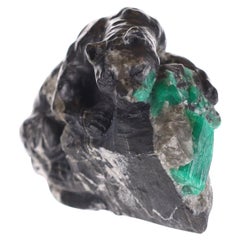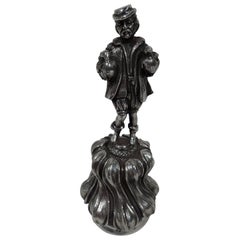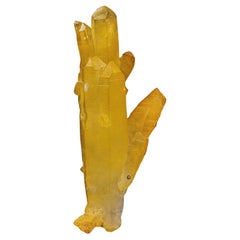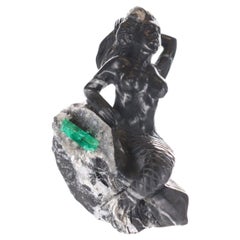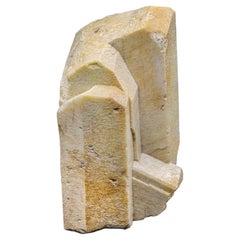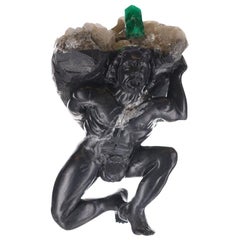Unisex Figurines and Sculptures
to
69
146
110
47
47
38
51
29
26
24
20
15
71
216
161
5
3
7
8
4
8
5
30
18
9
6
463
30
1
41
39
37
18
7
to
35
12
11
10
7
63
55
28
25
20
13
8
3
2
2
1
1
1
1
1
455
8
225
103
Gender: Unisex
Colombian Emerald Black Jaguar Rough Crystal Sculpture
Located in Jupiter, FL
This is a beautiful and one-of-a-kind rough Colombian emerald sculpture. Featuring a rare and exotic, hand-carved Jaguar but made of a mixture of black and gray shale. It is plotting...
Category
2010s Colombian Figurines and Sculptures
Antique Silver Belle with Figural Fowl-Bearing Countryman Handle
Located in New York, NY
Turn-of-the-century European silver bell. Tulip-bowl with twisted gadrooning. Figural handle depicting an old-fashioned countryman holding two live fowl. Here’s dinner—eventually. Su...
Category
Early 20th Century Unknown Edwardian Figurines and Sculptures
Materials
Silver
Sculptural And Impressive Elongated Iron Coated Quartz Crystals From Pakistan
Located in Bangkok, TH
Origin: Zhob District, Baluchistan Province, Pakistan
Dim: H: 12.5 x W: 5 x D: 2.5 cm
Wt: 112 g
Specimen Type: Sculptural and impressive elongated iron coated Quartz
Treatment: None
Color: Yellow
Iron-oxide coated Faden Quartz is a remarkable and aesthetically captivating variety of quartz crystal, distinguished by its unique physical characteristics and stunning visual appeal. The term "Faden" is derived from the German word for "thread," and this name perfectly encapsulates the defining feature of these crystals. Faden Quartz specimens exhibit a thin, thread-like inclusion of milky white quartz that runs through the crystal, often resembling a delicate and ethereal seam. This thread-like structure is typically encrusted with a layer of iron oxides, adding a warm and earthy coloration to the quartz.
quartz
quartz stone
quartz crystal
clear quartz
clear quartz crystal
golden healer...
Category
21st Century and Contemporary Pakistani Art Deco Figurines and Sculptures
Materials
Crystal, Quartz
$264 Sale Price
20% Off
Colombian Emerald Mermaid Rough Crystal Sculpture
Located in Jupiter, FL
This is a beautiful and one-of-a-kind rough Colombian emerald sculpture. It displays a gorgeous hand-carved mermaid of black and gray shale, with intricate detail from the scales of ...
Category
2010s Colombian Figurines and Sculptures
Luminescent Twinned Yellow Microcline Feldspar Couple Of Specimen From Pakistan
Located in Bangkok, TH
Dim: H: 19 x W: 9.3 x D: 8 cm
Wt: 2427 g
Treatment: None
Specimen Type: Lovely Twinned Microcline Feldspar specimen from Skardu, Pakistan
Color: Yellow
Presenting this love...
Category
21st Century and Contemporary Pakistani Art Deco Figurines and Sculptures
Materials
Crystal
$660 Sale Price
20% Off
Colombian Emerald Miner Rough Crystal Sculpture
Located in Jupiter, FL
Rough Emerald-
Color: Green
Clarity: Translucent
Origin: Colombia
Measurement: 20.99 mm x 9.74 mm
Sculpture-
Stone(s): Black Shale, Calcite
Measurement: 4.25" x 3" x 4.75"
Weight: 3...
Category
2010s Colombian Figurines and Sculptures
Colombian Emerald Egyptian Rough Crystal Sculpture
Located in Jupiter, FL
This is a beautiful and one-of-a-kind rough Colombian emerald sculpture. It is an Egyptian-styled rough; handcrafted, and made of natural black and gray shale with minimal traces of ...
Category
2010s Colombian Figurines and Sculptures
Colombian Emerald Bald Eagle Rough Crystal Sculpture
Located in Jupiter, FL
This is a beautiful and one-of-a-kind rough Colombian emerald sculpture. Our national bird, the bald eagle. This majestic head sculpture contains medium-dark, rough Colombian emerald...
Category
2010s Colombian Figurines and Sculptures
Colombian Emerald Alligator Rough Crystal Sculpture
Located in Jupiter, FL
This is a beautiful and one-of-a-kind rough Colombian emerald alligator sculpture. Hand-carved, and made of black shale, calcite, ambrosia, and natural Colombian emerald rough crystals...
Category
2010s Colombian Figurines and Sculptures
Hand Carved Animal Figure, Rat Talisman for Home
By MOISEIKIN
Located in Hong Kong, HK
The Urals in Russia are rich in semi-precious stones, so this region has become one of the leaders among the Russian "workshops" of artistic carving on marble, jasper, rhodonite, rock crystal and other ornamental stones. The beginning of the path of widespread dissemination of stone-cutting art in Russia dates back to the end of the 18th century. The tradition of the Ural art stone carving still exists. Skilled craftsmen of the MOISEIKIN not only preserve, but also develop the tradition, using the latest technologies and creativities to make original stone-cut sculptures.
Carved animal...
Category
Early 2000s Russian Contemporary Figurines and Sculptures
Colombian Emerald Armadillo Rough Crystal Sculpture
Located in Jupiter, FL
Rough Emerald-
Color: Green
Clarity: Opaque
Origin: Colombia
Sculpture-
Stone(s): Black Shale, Gray Shale, Calcite
Measurement: 4.5" x 2.25" x 1.5"
Weight: 300.6 Grams
Category
2010s Colombian Figurines and Sculptures
Colombian Emerald Dog Rough Crystal Sculpture
Located in Jupiter, FL
Rough Emerald-
Color: Green
Clarity: Translucent
Origin: Colombia
Measurements: 28.84 mm x 7.92 mm
Sculpture-
Stone(s): Black Shale, Gray Shale, White Calcite
Measurement: 1.75" x 1...
Category
2010s Colombian Figurines and Sculptures
Late XIXc Swiss Black Forest Carved Walnut Bear Side Table with Tobacco Jar
Located in MELBOURNE, AU
Highly collectable,
this Black Forest Tobacco Jar Side table
is meticulously carved from walnut
in a form of a bear climbing a finely deta...
Category
Antique 1890s Swiss Victorian Figurines and Sculptures
Louis Comfort Tiffany, Art Nouveau Iridescent Favrile Art Glass Vase
Located in Chicago, IL
A double extruded handled vase by famous designer, Louis Comfort Tiffany. This rare vase is a rich gold color with irridescent highlights of green, blue and pink. Favrile glass such ...
Category
Vintage 1910s American Art Nouveau Figurines and Sculptures
$2,400 Sale Price
20% Off
A Rare Buccellati Italy Sterling Silver Model of a Bull
By Buccellati
Located in Long Island City, NY
A Rare Buccellati Italy Sterling Silver Model of a Bull, Numbered 7
An impressive and finely detailed sterling silver model of a bull by Buccellati, Italy, numbered 7. Exquisitely h...
Category
20th Century Italian Figurines and Sculptures
Materials
Sterling Silver
Antique Chinese Carved Agate Cicada Pendant 19c Qing
Located in Richmond, CA
An almost life like antique Chinese carved agate cicada, with a loop between the bulging black eyes to wear as a pendant, and translucent life lik...
Category
Antique 19th Century Figurines and Sculptures
Sterling Silver Stirrup Cup Wine Glasses 'Vermeil Inside' Depicting a Dog
Located in Roma, IT
This dog is one of 12 sterling silver "stirrup" glasses, vermeil inside, whose models date back to around the mid-1900s, and represent 12 animals that can be placed at the table to serve wine.
Most popular in the late 18th and 19th century, antique silver stirrup cups...
Category
Vintage 1940s Italian Figurines and Sculptures
Materials
Vermeil, Sterling Silver
Authentic Roman Marble 'Serpentino' Sterling Silver Place-Holder Obelisk
Located in Roma, IT
This obelisk in "Lapis lacedaemonius", called in ancient Rome "Serpentino", was made by our talented artisans: the one who cut the precious ancient marble and the one who made the st...
Category
2010s Italian Classical Roman Figurines and Sculptures
Materials
Sterling Silver
Pair of Art Nouveau Bronze Marble Candlesticks
Located in Palm Beach, FL
A pair of tall Art Nouveau bronze candlesticks with white and orangish-brown marble spheres. Continental, circa 1890-1930. Measuring approximately 21.5" in height and 9" in diamete...
Category
Antique Early 1900s Unknown Art Nouveau Figurines and Sculptures
Materials
Bronze
$960 Sale Price
20% Off
Alex Soldier Essence of Woman Sculpture One of a Kind
By Alex Soldier
Located in New York, NY
Alex Soldier created a conceptual work of art titled Essence Of A Woman to celebrate women around the world in all of their incredibly versatile nature, character and beauty. The sta...
Category
2010s American Contemporary Figurines and Sculptures
Materials
Crystal, Onyx, Platinum, Rhodium, Silver, Sterling Silver
Male Doberman Dog Sculpture in Silver
Located in Milano, Lombardia
Male Doberman dog sculpture in Silver
Category
Vintage 1980s Italian Early Victorian Figurines and Sculptures
Materials
Silver
Hand Painted Multicolored Porcelain Parrot, Meissen Manufactory
Located in Roma, IT
This beautiful parrot was made by the Meissen factory, perhaps the oldest and most prestigious porcelain factory in Europe, using the model created by Kandler in the 1700s.
In 1731 t...
Category
2010s German Figurines and Sculptures
40 Ct Natural Emerald Fish Carving
Located in Bangkok, TH
A synergy between gemstone and art enclosed in a subtle piece - Emerald Fish Carving.
In modern spiritual beliefs and practice, fish have come to symboli...
Category
2010s Thai Artisan Figurines and Sculptures
Materials
Emerald
Hand Painted Multicolored Porcelain Parrot, Meissen Manufactory
Located in Roma, IT
This beautiful parrot was made by the Meissen factory, perhaps the oldest and most prestigious porcelain factory in Europe, using the model created by Kandler in the 1700s.
In 1731 t...
Category
2010s German Figurines and Sculptures
Sculpture of Dog Cocker in Silver
Located in Milano, Lombardia
Sculpture of dog Cocker in silver
Category
Antique 1880s Italian Early Victorian Figurines and Sculptures
Materials
Silver
Radha Krishna God Aquamarine Figurine
Located in New York, NY
An exceptionally stunning carving of the Hindu Gods Radha & Krishna in a rare Bi-Color Aquamarine with paint work as well. The figurine’s dimensions are 2” ...
Category
2010s Figurines and Sculptures
Materials
Aquamarine
$10,000 Sale Price
25% Off
A spinach green nephrite jade dagger hilt Asian art and armour
Located in Bangkok,, TH
A nephrite jade hilt carved with from a single rock piece, the appeal of this elegant design lies mainly in the perfect proportions of its hilt, and the exce...
Category
Early 2000s Indian Figurines and Sculptures
Materials
Jade
Dog Sculpture Poodle in Silver
Located in Milano, Lombardia
Dog sculpture poodle in silver
Category
Vintage 1980s Italian Early Victorian Figurines and Sculptures
Materials
Silver
Russian Antique Imperial Nephrite Sterling Silver Rat Sculpture
Located in New York, NY
This exquisite Russian Imperial sculpture features a rat in a top hat with a movable cane crafted out of sterling silver and nephrite. The nephrite is medium to medium light muddy gr...
Category
Antique Early 1900s Figurines and Sculptures
Materials
Sterling Silver
Rare Important Bronze Estate Gladenbeck Bronze Boy on Marble Sculpture
Located in New York, NY
An Exquisite and Beautiful Museum Quality Estate Bronze boy holding monkey. The Bronze with a mid brown patina, depicting the young boy with the monkey hanging from his shirt, on cir...
Category
Antique 19th Century Figurines and Sculptures
Materials
Bronze
1950s Lizard Diamond Yellow Gold 18 Karat Brooch Clip
Located in Geneva, CH
The Animal Lizard brooch clip in yellow gold 18k is a captivating piece of jewelry.
This brooch features a lizard design, crafted with meticulous attention to detail.
The lizard’s eyes are adorned with rose cut diamonds, adding a touch of sparkle and elegance. The head of the lizard is crowned by a beautiful pink sapphire, enhancing its regal appearance. This brooch is estimated to be from the 1950s and bears French assay marks, indicating its authenticity and quality. With its unique design and exquisite gemstone accents, this lizard brooch is a timeless and sophisticated accessory.
Total length: 2.56 inches (6.50 centimeters).
Total weight: 10.66 grams.
We are reknown for curating unfindable jewels.
Most of the pieces of our collection are antique, one-of-a-kind and formerly owned by...
Category
Vintage 1950s French Artist Brooches
Materials
Pink Sapphire, Gold
"Barcaccia" Fountain Herend Porcelain Centerpiece Exclusive for SERRA
By Herend
Located in Roma, IT
This reproduction of Bernini's Barcaccia, located near the Spanish steps in Rome, was made by Herend exclusively for the Serra shop, using a sterling silver model that Serra had created (with the help of the artist Foscolo Benedetti), and had then supplied to Herend. The director of the prestigious Hungarian manufacture, a great lover of Italian history and art, was so enthusiastic about the model that he proposed making it an elegant and unique centerpiece, exclusive for Serra, which can be decorated with all the famous Herend decorations. Here we see the "Victoria" decoration, made at the end of the 19th century for Queen Victoria, and still used by the English royal house.
Pope Urban VIII commissioned Pietro Bernini in 1623 to build the fountain as part of a prior Papal project to erect a fountain in every major piazza in Rome. The fountain was completed between 1627 and 1629 by Pietro possibly along with the help of his son Gian Lorenzo Bernini, especially after his father's death on August 29, 1629.
The sculptural fountain is made into the shape of a half-sunken ship...
Category
1990s Figurines and Sculptures
Imperial Austrian Court Miniature Royal Hungarian Crown Guard Helmet
Located in Montreal, QC
Imperial Austrian court miniature helmet and royal Hungarian crown guard. Maker unknown, silver-plated, parcel gilt. Measures 8cm tall, circa 1900. In...
Category
Antique Early 1900s Austrian Figurines and Sculptures
Silver Hound Bracco handicraft
Located in Milano, Lombardia
Silver hound bracco handicraft
Category
Vintage 1980s Italian Early Victorian Figurines and Sculptures
Materials
Silver
19th Century Albert-Ernest Carrier-Belleuse Bronze Sculpture of Seated Virgil
By Albert-Ernest Carrier-Belleuse
Located in Hicksville, NY
French Second-Empire artist Albert Ernest Carrier-Belleuse is known as the most prolific sculptor of this period. His sculptures were displayed in the Tuileries, the Louvre and the O...
Category
Antique Late 19th Century French Napoleon III Figurines and Sculptures
Materials
Bronze
Antique Chinese Jadeite Recumbent Cat Pendant Turquoise Inlaid Eyes 19c Qing
Located in Richmond, CA
A wonderful and cute antique Chinese carved jadeite recumbent cat, comfortably nested in a matching hardwood stand. The almost fluffy looking cat's intense greenish blue eyes are inl...
Category
Antique 19th Century Figurines and Sculptures
Materials
Jade
Pineapple Handicraft in Silver
Located in Milano, Lombardia
Pineapple handicraft in silver
Category
Vintage 1980s Italian Early Victorian Figurines and Sculptures
Materials
Silver
14.87 Ct Emerald Green Carving Frog
Located in Bangkok, TH
This green Emerald is curved, as if the frog is resting on a leaf. The emerald also features an exceptionally vivid green color. It is carefully curved and expertly crafted to enhan...
Category
2010s Thai Artisan Figurines and Sculptures
Materials
Emerald
Colombian Emerald Red Panda Rough Crystal Sculpture
Located in Jupiter, FL
This beautiful and one-of-a-kind rough Colombian emerald sculpture. Featuring the one and only red panda; hand-carved with intricate detail along its coat and tail made of black and gray shale. The panda sits over a cliff with a natural Colombian emerald rough displayed. Red Pandas...
Category
2010s Colombian Figurines and Sculptures
Bronze Modernist Figure by Miguel Fernando Lopez Milo
Located in London, GB
Bronze Modernist Miguel Figure by Fernando Lopez Milo
A semi -abstract sculpture of Venus by Portuguese artist Miguel Fernando
Lopez on marble base.
Late 20th century. Floral designs on bronze
In excellent condition.
Signed MILO. Stamped with foundry mark in a circular plaque marked BRONZE GARANTI PARIS...
Category
Antique Late 19th Century European Artist Figurines and Sculptures
Materials
Bronze
18K Gold transforming jewellery Interior Object by Viktor Moiseikin
Located in Hong Kong, HK
All in this world is a reflection
Of divine love and eternal art.
And we're seeking inspiration,
In the feelings – strings of soul harps.
-Viktor Moiseikin -
The 'Serenity' interior decoration by MOISEIKIN is a beautiful combination of modern and traditional jewellery art. The large carved quartz jewel plate, in which you can place your jewellery, represents the water where the natural lives concentrate. Delicately carved Clematis leaves made of jade and gold gently as if embracing precious pure water. The golden fluttering butterfly and snail are embedded with precious gems that bring charm. One beautiful and shining moment of nature is precisely and artistically reflected in this gold and jewellery artwork...
Category
2010s Thai Artisan Figurines and Sculptures
Materials
Amethyst, Diamond, Garnet, Jade, Cultured Pearl, Quartz, Sapphire, 18k G...
Price Upon Request
Stone Carving Art Cat Miniature
By MOISEIKIN
Located in Hong Kong, HK
MOISEIKIN created a cat miniature using mosaic and carving techniques. Specialized in glyptography, the carved hairs and facial features are detailed. The s...
Category
2010s Russian Arts and Crafts Figurines and Sculptures
Materials
Quartz, Tiger's Eye, Jasper
Price Upon Request
18 Karat Gold Flower Miniature Precious Berries by MOISEIKIN
By MOISEIKIN
Located in Hong Kong, HK
Gold floral compositions with precious or semi-precious stones or enamel became popular at the turn of the 20th century in Europe and Russia. Especially Imperial families and nobilities collected or gifted to important people.
The flowers are carved from cacholong —Russian milky opals — look so tender and natural.
Berries are skillfully cut from citrine and garnets. Golden stems are carved lively and embedded with rare Ural demantoid garnets. Fresh nephrite leaves are carved by hands. The intricate dewdrop is intricate.. embedded with diamonds.
On a green jasper ground, a lucky ladybug made of gold, rubies and black diamonds is enjoying the moment.
Perfectly expressed in the precious metal and stones by skillful craftsmen of MOISEIKIN®, the pleasant memory will not fade away.
This flower miniature is one of Precious Berry Collections and another piece is possessed by a known royalty who collects flower...
Category
21st Century and Contemporary Russian Contemporary Figurines and Sculptures
Materials
Citrine, Diamond, Garnet, Jade, 18k Gold
Price Upon Request
